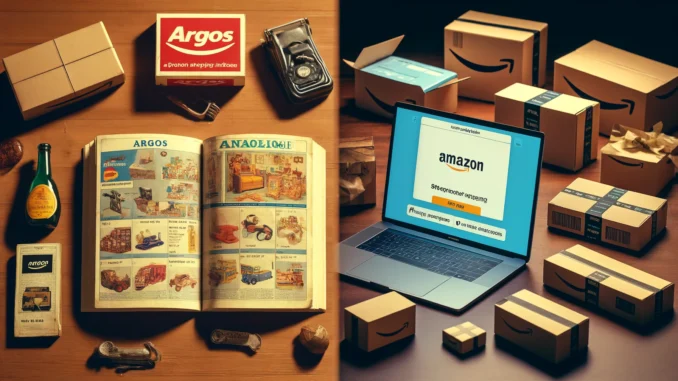
Introduction: A Shopping Experience Lost in Time
Once upon a time, the thrill of shopping wasn’t in clicking a button—it was in flipping pages. If you grew up in the UK, there was one book that mattered as much as any novel or comic strip: the Argos catalogue. As children, we circled Christmas presents, as adults, we compared home electronics, all within the pages of a free, laminated tome of consumer dreams. And when the decision was made, the process felt almost futuristic—walk into an Argos store, punch in a code on a kiosk, and moments later, your purchase materialized from the stockroom.
Then came Amazon.
What started as an online bookseller became the behemoth that rewrote retail. Suddenly, you didn’t need to check stock or leave your house. You clicked, and a package arrived as soon as the next day. The retail experience had transformed forever. But was something lost in the process?
This is the story of how Argos paved the way for retail evolution, how Amazon perfected digital shopping, and what it means for the future of consumer habits.
The Golden Age of Argos: A Retail Evolution Before the Internet
Argos wasn’t just a warehouse-store hybrid—it was a precursor to e-commerce before e-commerce existed, bridging the gap between traditional mail-order catalogues and the digital future. Unlike companies that relied solely on postal orders, Argos offered a streamlined, rapid in-store fulfillment system that gave customers the convenience of selecting products at home while avoiding the delays of mail-order deliveries. Founded in 1973, Argos introduced an innovative system where customers browsed at home, placed an order, and collected their items in-store.
By the 1990s and early 2000s, Argos was ahead of the curve:
- Self-service kiosks—A touchscreen interface in-store let customers browse stock and make orders, foreshadowing the online checkout experience.
- Click & Collect—Order online and pick up at a store, a system Amazon would later integrate through its own pickup locations.
- Barcode scanning and automated fulfillment—Long before Amazon’s warehouses, Argos had a logistics system designed for speed and efficiency.
At its peak, Argos was the future of shopping before the internet caught up. The question was: could it survive in a world that would soon be dominated by pure online retail?
The Amazon Effect: How Retail Evolution Shifted to Digital Domination
While Argos bridged catalogue shopping with digital convenience, Amazon took a no-storefront approach and built a fully digital empire.
Amazon’s competitive advantage wasn’t just its wide selection—it was its logistics mastery:
- One-Click Ordering—Amazon reduced friction, making shopping almost too easy.
- Personalized Shopping—AI-driven recommendations ensured you saw products before you even knew you needed them. For example, Amazon’s algorithm might notice you recently searched for hiking gear and, without prompting, suggest a bundle of trekking poles, a hydration pack, and trail snacks—shaping your purchasing decisions before you even realize a need for them.
- Warehouses Instead of Shops—By eliminating physical storefronts, Amazon built an unstoppable fulfillment network.
Argos had convenience, but Amazon had scale, speed, and predictive technology. By the mid-2010s, Argos’ paper catalogues were being phased out, while Amazon’s AI-driven, algorithm-powered shopping experience was changing consumer behavior.
Retail Evolution: Argos’ Reinvention in the Digital Age
Many thought Argos would become another casualty of the Amazon era—but instead, it evolved.
- From Warehouse to Click & Collect Giant—By 2016, Argos had fully digitized, replacing catalogues with an e-commerce-first approach.
- Strategic Partnership with Sainsbury’s—Rather than compete directly with Amazon, Argos integrated into Sainsbury’s supermarkets, providing rapid in-store fulfillment.
- Same-Day Delivery—To counter Amazon’s speed, Argos launched Fast Track, making same-day delivery mainstream in the UK before Amazon Prime Now was fully established.
Argos didn’t just survive—it adapted, using its physical locations as an advantage where Amazon still needed pickup hubs.
Retail’s Future: Can We Reclaim the Joy of Shopping?
Amazon’s AI-driven recommendations have made shopping incredibly efficient—but have they made it less fun?
- The Death of Browsing: Instead of flipping through pages or wandering aisles, we see only what the algorithm decides.
- Logistics Over Choice: The focus isn’t on variety and exploration, but speed and supply-chain optimization.
- The Joy of Anticipation is Gone: With Argos, the wait—flipping through the catalogue, the trip to the store—was part of the excitement. Now? We expect items immediately.
But new trends suggest that people still crave a tactile shopping experience:
- Vinyl records are booming despite digital music.
- Independent bookstores are growing as a reaction to Amazon’s dominance.
- More consumers are choosing to shop local, despite the convenience of online giants.
Could it be that the future of retail is hybrid—where both instant gratification and the joy of discovery coexist?
Retail Evolution: What Did We Lose, and What Comes Next?
From Argos’ paper catalogues to Amazon’s predictive AI, shopping has changed forever. We’ve gained speed and efficiency, but lost the personal touch and the thrill of browsing.
Maybe the next revolution won’t be faster shipping—it’ll be about bringing back the joy of shopping. Retailers could achieve this by blending AI-driven convenience with immersive in-store experiences, such as augmented reality for virtual try-ons, curated discovery sections in physical stores, or hybrid models where customers can browse tactile catalogues in-store while enjoying the ease of digital checkout.
What do you think? Do you miss flipping through catalogues, or do you prefer instant AI-driven shopping? Has Argos or Amazon shaped how you shop today? Share your thoughts!

Leave a Reply